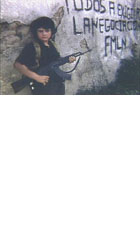
Five Days To Change The World 2001
Distributed by New Day Films, 190 Route 17M, P.O. Box 1084, Harriman, NY 10926; 888-367-9154 or 845-774-7051
Produced by Robert Richter
Directed by Robert Richter
VHS, color, 57 min.
Sr. High - Adult
Political Science, Human Rights
Date Entered: 11/09/2018
Reviewed by Susan DeMasi, Ammerman Campus Library, Suffolk County Community College, Selden, NYThe title refers to the five days at the Hague Appeal for Peace and Justice, a conference largely ignored by the mainstream media, but captured by the producer.
Billed as the largest peace conference in history (over 10,000 people from 100 countries), this account, narrated by Martin Sheen, follows a group of young people who attended the conference. The producer focuses on their quest to break away from the main group at the gathering, and create their own “agenda for peace” to offer to Kofi Annan and the United Nations.
The earnest perspectives of the young people who came to the Netherlands in 1999 are presented. Viewers also get heartbreaking and inspirational stories (along with archival footage and photographs) from the many children and youths from war torn countries.
Although some segments may seem slow moving (i.e., watching the youth delegates in a meeting as they discuss the minutiae of forming their agenda), it’s also a worthwhile opportunity to see consensus-making in progress, and to get a small grasp on the complexity of these peace issues.
Like the conference itself, everything about this production is well-meaning, though sometimes unfocused. The narrative jumps, for instance, from the “rebel” youths’ meetings to dignitaries’ speeches and musical presentations.
The fact that these young people had the opportunity to interact with attendees and speakers such as Nobel Peace Prize winners Kofi Annan, Desmond Tutu, Jose Ramos Horta and others can be motivating to students. It can also be useful for them to see that important events are very often ignored by the mainstream media. (On this particular topic, a highly recommended documentary would be Independent Media In A Time of War, a recent documentary featuring independent journalist Amy Goodman. It’s produced by Brenda Miller and Hudson Mohawk Indy Media and distributed by Media Education Foundation – http://www.mediaed.org.)
All of this, however, doesn’t change the fact that this quest for peace was made pre 9/11 and the war in Iraq. And that, besides dating the tape, changes everything. How will viewers feel when they watch this? Perhaps, like this reviewer, that the efforts of all of these well-meaning people were futile. To hear Sheen talk towards the end of the documentary about progress that’s been made toward peace initiatives is also disheartening in light of current world events, not just here and in Iraq, but in the Middle East and too many other parts of the world.
But if it stirs debate about how United States foreign policy is formed and acted upon, and how United Nations objectives are often thwarted, it’s worth it. And if it impassions any young people to work for peace, that too, will make it worthwhile. It is recommended, albeit with reservations.